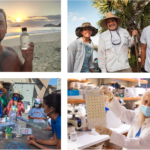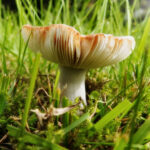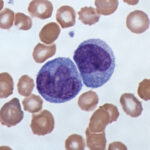How Do Soil Microbial Communities Recover from Wildfires?
Scientists examine how soil microbial communities resume ecosystem functioning after a wildfire, with a focus on the effects of dispersal.
In the aftermath of a wildfire, soil microbial communities might not seem like a top priority. Yet these microscopic critters play vital roles. They act as decomposers (breaking down organic material in the soil to release nutrients) and they interact both positively and negatively with plant communities. The effects of wildfire on soil microbial communities may be just as drastic as its effects on vegetation, albeit less visible. Soil microbes may be directly affected by the heat of the fire, or indirectly affected via changed physical and chemical properties of the soil and leaf litter. Yet while the post-fire recovery of plant communities has long been studied by ecologists, the fate of soil microbes in this context is not so well characterized.
“Succession” is a term used by ecologists to refer to the ways in which the mixture of species present at a site changes over time. These changes may occur as a new habitat is colonized for the first time (for instance, a recently formed volcanic island) or after a disturbance such as fire disrupts the stable community at a site. Scientists took advantage of a wildfire which took place in Southern California in 2020 in order to study the post-fire succession of soil microbial communities.
There are several mechanisms that might affect soil microbial community succession, including random drift and selection pressures imposed by environmental conditions. However, the scientists in this research study chose to focus on the role of one particular influence shaping soil microbial communities: dispersal. This simply means the movement of organisms (or their propagules—seeds or spores) to new locations, and can lead to new species colonizing an area. You might be more familiar with the idea of dispersal in relation to seeds. Perhaps you’ve learned about how dandelion seeds are adapted to wind dispersal, for example. Questions about dispersal are just as important in relation to microorganisms, though they can be harder to answer.
How do we study what we cannot see?
Two broad approaches help scientists in addressing their ecological questions. They might take an experimental approach of deliberately manipulating a variable and measuring a response. Various different scales are possible—experiments may take place in the lab, the greenhouse, or out in the field. Or, they might take a more observational approach, by measuring a variable of interest across different natural settings and looking for patterns in the data.
Let’s put this into the context of wildfire effects on microbes. An experimental approach might entail deliberately burning the vegetation in selected plots of a field site and comparing the microbial communities in these plots with the microbial communities in other plots that were left unburned. An observational approach, meanwhile, might be to analyze microbial community data from a range of sites that experienced wildfire at different time points or not at all. Each approach has its advantages and disadvantages. Experimental approaches enable us to focus specifically on a particular variable, keeping all others carefully controlled. The real world is a lot messier and more complicated than most experimental set-ups, however, so conclusions drawn from experiments do not always apply to natural ecosystems.
The strategy used by the study we are looking at here combined elements of both the experimental and the observational approach. There was no need for the scientists to simulate a wildfire, as they were able to take advantage of a real wildfire that had occurred at their South California study site in 2020. The fire affected two different ecosystem types: coastal sage scrub and semi-arid grassland. Because they had available data on pre-fire soil microbial communities at the site, it was relatively straightforward to deduce changes in those communities associated with the fire. Scientists extracted DNA from leaf litter samples collected shortly after the fire, sequenced the DNA to obtain a comprehensive picture of the microbial community, and compared this to the equivalent data from before the fire.
RELATED: Human Migration Trends Toward Wildfire Hot Spots
Focusing specifically on the role of dispersal, however, was trickier. For this, experimental manipulation was required. The scientists collected leaf litter from each of the ecosystem types, and placed it in two kinds of bags. “Open” bags were made of 2 mm mesh, whereas “closed” bags were made of nylon with 0.22 μm pores (1 μm is 0.001 mm). They knew from previous work that the “open” bags would allow microbial cells to enter the bags from outside, whereas would-be microbial immigrants would be unable to squeeze through the tiny gaps in the “closed” bags. Therefore, when they replaced the bags full of litter in the sites from which they were taken, microbial community succession in the “open” bags would be influenced by dispersal, but microbial community succession in the “closed” bags would not. The scientists collected subsets of the bags at different time intervals, analyzed the microbial communities inside each by sequencing their DNA, and compared the results between “open” and “closed” bags. This process enabled them to see what effect dispersal had on post-fire microbial succession.
Patterns in post-fire soil microbial communities
Unsurprisingly, the study confirmed that wildfire has a major impact on soil microbial communities. Pre- and post-fire communities at the site were found to be significantly different. Beyond this, the results were complex, but some broad points emerged. Dispersal was confirmed as an important influence on post-fire soil microbial community composition. Dispersal explained between 15 percent and 34 percent of variation in bacterial and fungal communities across the two different ecosystems. These percentages, however, raise questions about other drivers of microbial community succession. If less than half of the variation in microbial communities is due to new microbes migrating in from elsewhere, then what is causing the variation? Perhaps environmental pressures are favoring some of the microbes already present in the post-fire leaf litter, while driving others extinct. The after-effects of fire could stimulate microbial evolution to adapt to the changing conditions. Further research, however, would be necessary to untangle the various possible influences.
RELATED: Monitoring Soil Health through Citizen Science
The study also shed light on where the immigrating microbes were coming from. They did this by comparing the species that were immigrating into the “open” bags with the species found in air, bulk soil, and surrounding leaf litter outside the bags. Across all sampling times, immigrating bacteria appeared to be mainly from the air or the wider leaf litter, whereas air alone was the major source of dispersing fungi. These findings came as a surprise, since the scientists had expected bulk soil to be much more important as a source of dispersing microbes than it actually was. It might also make us stop and wonder at all those bacterial cells and fungal spores floating invisibly in the air we breathe!
Complex variations were apparent both over time and between the two different ecosystem types. The species composition of microbes dispersing into the bags varied over time, as did their abundance and diversity. This may reflect long-term trends as the ecosystem recovered after the fire, but the study researchers also note a possible seasonal component; abundance and diversity are both higher in the wet season.
The researchers found different patterns in the different ecosystems, particularly for diversity, as well as differences between bacteria and fungi. We can look at diversity on different scales: alpha diversity (α-diversity) is the diversity of the community at a single sampling location, whereas beta diversity (β-diversity) is the diversity between different sampling locations. For instance, if a lot of different microbial species were found in one of the bags, then it would have high alpha diversity. However, if the other bags all contained the same species in similar proportions, then the beta diversity would be low. For bacteria, dispersal had opposite effects on alpha and beta diversity, and inverse patterns for both were seen between the two different ecosystem types. Ecosystem type was in fact found to be the most important influence on microbial community composition—more important than dispersal. These complexities point to the need for further research in this area, as there is clearly no “one size fits all” template for post-fire microbial community succession.
RELATED: Microbes Help Plants Survive Heavy Metal Stress
What soil microbial communities do for us, and what we can do for them
Although wildfires are a natural occurrence in some ecosystems, the risk of wildfire is predicted to increase with climate change. As we work to restore fire-hit ecosystems, we must not overlook the soil microbial communities that underpin them. Though some microbes can be pathogenic, others play vital roles in nutrient cycling and in helping plants to thrive in adverse circumstances. Interventions to help the recovery of a burned site by manipulating the microbial communities, for instance by reintroducing beneficial species, may become an option. But for this to work, we need a better understanding of how soil microbial communities develop after a fire.
This study was published in the peer-reviewed journal mSystems.
References
Barbour, K. M., Weihe, C., Walters, K. E., & Martiny, J. B. H. (2023). Testing the contribution of dispersal to microbial succession following a wildfire. mSystems, 8(5), e00579-23. https://doi.org/10.1128/msystems.00579-23
Nemergut, D. R., Schmidt, S. K., Fukami, T., O’Neill, S. P., Bilinski, T. M., Stanish, L. F., Knelman, J. E., Darcy, J. L., Lynch, R. C., Wickey, P., & Ferrenberg, S. (2013). Patterns and processes of microbial community assembly. Microbiology and Molecular Biology Reviews, 77(3), 342–356. https://doi.org/10.1128/mmbr.00051-12


About the Author
Rachel Calder’s PhD project focuses on mycorrhizal fungi and soil nutrient cycling, but she is also an inveterate dabbler with a wide enthusiasm for all things Science. Having started out studying history herself, she’s also a big advocate for transcending the arts/sciences divide.




